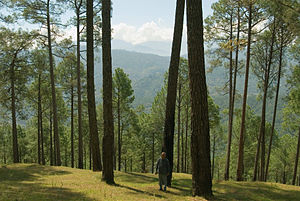Himalayan subtropical pine forests
| Himalayan subtropical pine forests | |
|---|---|

|
|
| Ecology | |
| Biome | Tropical and subtropical coniferous forests |
| Borders |
|
| Bird species | 469 |
| Mammal species | 162 |
| Geography | |
| Area | 76,200 km2 (29,400 sq mi) |
| Countries | India, Bhutan, Nepal and Pakistan |
| Conservation | |
| Habitat loss | 86.65% |
| Protected | 4.09% |
The Himalayan subtropical pine forests are a large subtropical coniferous forest ecoregion covering portions of Bhutan, India, Nepal, and Pakistan.
This huge pine forest stretches for 3000 km across the lower elevations of the great Himalaya range for almost its entire length including parts of Pakistan's Punjab Province in the west through Azad Kashmir, the northern Indian states of Jammu and Kashmir, Himachal Pradesh, Uttarakhand and Sikkim, Nepal and Bhutan, which is the eastern extent of the pine forest. Like so many Himalayan ecosystems the pine forests are split by the deep Kali Gandaki Gorge in Nepal, to the west of which the forest is slightly drier while it is wetter and thicker to the east where the monsoon rains coming off the Bay of Bengal bring more moisture.
The predominant flora of the ecoregion is a thin woodland of drought-resistant Chir pine (Pinus roxburghii) trees with a ground cover of thick grass, as regular fires do not allow a shrubby undergrowth to establish itself. The ground cover consists of Arundinella setosa, cogon grass (Imperata cylindrica) and Themeda anathera.
Pine forest mainly grows on south-facing slopes although in western Nepal there are areas facing in other directions. Some of the larger areas can be found in the lower elevations of Kangra and Una Districts of Himachal Pradesh and in Bhutan. It occurs in smaller patches in eastern Himachal Pradesh and lower Uttarakhand, in the more thinly populated western Nepal, and on the lower elevations (between 1,000 and 2,000m) of the Sivalik and Mahabharat ranges.
...
Wikipedia
